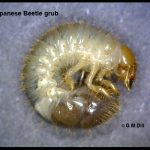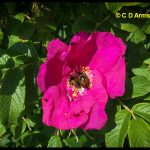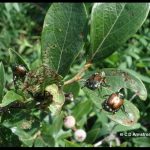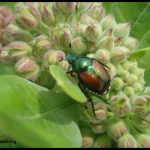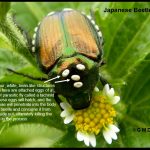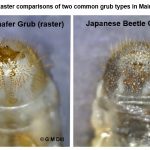Japanese Beetles
The Japanese beetle, Popillia japonica, is a scarab beetle about 3/8“ long. The head and thorax are metallic green and the elytra (outer wing covers) are copper-colored. Adult feeding damage appears as lacy leaves, as in the photos below. The beetles feed on over 400 plants including rose, raspberry, bean, grape and blueberry. The adults are good fliers and can move from one area to another in large swarms. When threatened, adults will feign death, dropping from the plant. For information regarding management of Japanese beetles, please visit our fact sheet located at: https://extension.umaine.edu/ipm/ipddl/publications/5037e/
The larval stage of the Japanese beetle is a C-shaped white grub similar in appearance to the June beetle, rose chafer and European chafer. Japanese beetle grubs can be a major turf pest. A good indicator of a white grub infestation is skunks digging up the lawn. White grub treatment threshold is typically 8-10 grubs per square foot.
- Japanese Beetle Larva/Grub
- Japanese Beetles feeding on a wild rose blossom; Seal Harbor, ME – August 7, 2020
- Japanese Beetles
- A mating pair of Japanese Beetles on highbush blueberry (Albion, Maine; 7/27/2009)
- Japanese Beetles on highbush blueberry
- A cluster of Japanese Beetles
- Japanese Beetle on a milkweed plant
- Japanese Beetle with four eggs from a parasitic fly called a tachinid fly. Leaving such beetles alone is advisable because it may lead to additional tachinid flies that can go on to parasitize additional beetles (such parasitism typically kills the beetle).
- Japanese Beetle (Popillia japonica) (parasitized with four white eggs from a tachinid fly) (Etna, ME; 7/30/2015)
- Comparing the rasters of Japanese Beetle and European Chafer grubs.
- Feeding injury from Japanese beetles on winterberry holly leaves (Etna, ME; 7/7/2024)
Additional Information (includes ‘Life Cycle’ and ‘Management’):
- Japanese Beetles (Bulletin #5037; our published fact sheet)
- Plant Tolerance of Japanese Beetles
- Japanese Beetles in the Home Garden (Penn State)
- Japanese Beetles in your Yard and Garden (Univ. of Minnesota)
- See also the following UMaine Extension video about things you can do to help control them:

